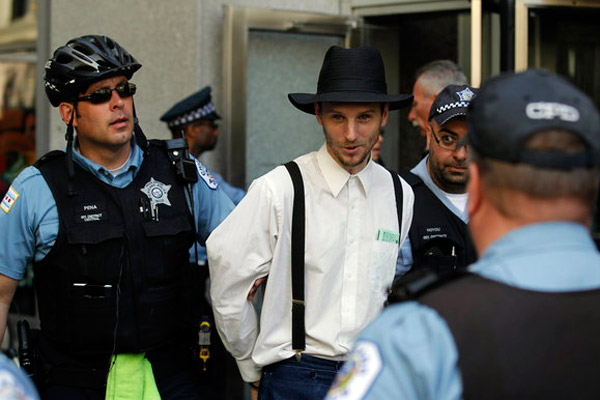
The planned NATO protests kicked off a bit earlier than expected: eight members of a Catholic Worker-organized, 100-protester group were arrested inside the building housing Obama's 2012 headquarters. It's currently the top story at MSNBC. What's interesting is how it went down:
Guards locked the revolving doors, but protesters slipped through unlocked doors off to the sides. Some pushed past a security guard who tried to block their entry but quickly gave up as protesters poured through the doorway.
About a dozen uniformed Chicago police officers entered the lobby and stood quietly at the back of the protest group as a demonstrator on the second floor read a statement, echoed by the few dozen demonstrators in the lobby below.
[snip]
After the statement was read, most of the protesters filed out past the police, with one shaking hands with the building manager and a police lieutenant.
[snip]
A handful of protesters remained inside near the elevator banks to the upper floors and refused to leave when asked by the building manager and police. They were handcuffed and escorted out a side door, singing “This Little Light of Mine.”
The protesters circumvented building security, but the CPD allowed them a brief protest inside the building; the only protesters arrested were those who refused to leave when asked.
It strikes me as a modestly encouraging start. Despite making it inside a private building at the time most employees would be arriving for work, both the police and protesters were fairly flexible: they were given the opportunity to leave, and most did so when asked.
From the perspective of right of assembly, it might not sound like much, but consider Boston in 2004:
The Boston experience looms large in the minds of political convention protesters because it was there that the city relegated them to an area underneath an abandoned elevated train track.
Court documents say two-thirds of the space had a height of only six feet. In addition to razor wire left over from the track, the city erected two rows of concrete barriers and eight foot high fencing.
The "Free Speech Zone" looked like something out of Children of Men.
Legal scholar and Drexel professor Tabatha Abu El-Haj calls this our "neglected right to assembly," and compares it unfavorably with early American political participation:
The existence of a right of peaceable assembly was not controversial at the founding because it “was a traditional right of English freemen.” It was included virtually without comment in the First Amendment. Indeed, "in the first United States Congress a discussion of the proposed Bill of Rights amendment [regarding assembly] was declared beneath the dignity of the members."
The right was understood primarily to protect a democratic practice. Madison’s first list of proposed amendments “separated the clause for the rights of assembly, consultation, and petition from the clause containing the free expression guarantees of speech and the press”—that is, separating the collective rights from the individual ones.
This remained true through the beginning of the last century:
[L]ate nineteenth-century courts generally balked when faced with the kinds of ordinances that we take for granted as constitutional exercises of the police power. Their skepticism was driven, in part, by the recognition that these ordinances broke from American political and regulatory traditions that comported with their understanding of the right of assembly. The risks of disorder and of interfering with the rights of passersby were not considered sufficiently serious to justify the ordinances.
We're well away from the role of public protest accepted by Americans (and their governments) for the first hundred-plus years of their history, but things have also improved modestly since the low point of the Boston DNC. The whole world won't just be watching NATO or the protesters; it will also be looking towards the city for guidance on free assembly.
Photograph: Chicago Tribune


